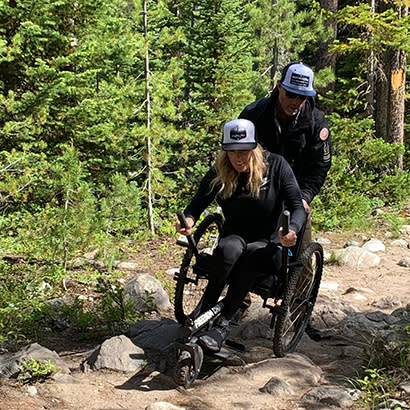
For an enhanced digital experience, read this story in the ezine.
As parks continue to serve as sanctuaries for outdoor recreation, it is encouraging to see park and recreation professionals improving access for visitors with disabilities. Gone are the days when wheelchair users were limited to short, paved and unexciting paths. Agencies around the country have been working to make their trails more accessible. The programs are as varied as the outdoor enthusiasts who participate, with some locations offering first-come, first-served adaptive equipment rentals and others providing scheduled ranger-led adaptive hikes.
In our work supporting, building and facilitating adaptive outdoor recreation programs, we’ve learned some key lessons:
1 Provide objective trail information.
While it sounds appealing to rate trails like ski runs, that type of system is simply too subjective. Any skier will tell you that a Blue Square at one mountain can be dramatically different from a Blue Square at another. When rating trails for adaptive outdoor recreation, the best thing any organization can do is to provide as much objective trail information as possible.
Offering a wealth of objective information about the trail will empower the person with a disability to make their own decisions based on their unique needs and goals. With variables like disability, skill and type of equipment, stamping “blue” or “green” at the beginning doesn’t help all that much. What does help, however, is basic information for each trail, such as: total trail length, minimum trail width, overall grade, average and max cross-slope, surface type, and maximum incline. If there is anything that may be a major impediment to mobility, call it out and note where on the trail it occurs. Also include facility-wide accessibility information.
2 There are many program models.
Being open to different program models allows you to select the one that works best for your organization, location, budget and needs. One common model is to first focus on improving the trails themselves; another is to first focus on adding adaptive equipment to navigate the existing trails.
When the Legacy Parks Foundation in Tennessee had the opportunity to develop 42 acres of forested land adjacent to an existing park, it created an all-access trail that accommodates visitors using all-terrain wheelchairs and handcycles. However, Texas State Parks began by offering all-terrain wheelchairs at some of its visitor centers so visitors could borrow them to explore the trails onsite. Meanwhile, City of Reno’s Adaptive and Inclusion Program features an equipment rental program. This approach allows participants to rent devices like all-terrain wheelchairs and adaptive mountain bikes and use them on the trails of their choice, all on their desired schedule.
3 Adaptive equipment expands options.
People with disabilities can utilize all-terrain wheelchairs, adaptive mountain bikes and adaptive hiking aids to tackle uneven surfaces on trails. There are many options, from battery-powered chairs with tank-like treads to knobby-tired manual wheelchairs propelled with levers. Some chairs are exclusively self-propelled, some exclusively are pushed by a caregiver, and others enable individuals or full teams to contribute.
If this feels like more than your organization can do all at once, that is okay! Even slight updates to your signage or a single piece of adaptive equipment can dramatically improve the visitor experience.
Tish Scolnik is Co-Founder and CEO of GRIT. April Wolfe is Therapeutic Recreation Specialist at City of Reno, Nevada.

